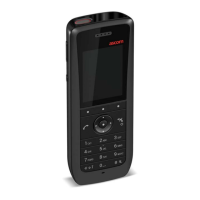TD 93119EN
28 June 2016 / Ver. PA5
User Manual
Ascom d63 DECT Handset
54
8.2.2 Missed Calls
NOTE: The dialog window that appears for a misse
d call can be turned off. The handset can
also be prevented from storing calls in the call list. The latter feature can for example be
used to ensure privacy for users sharing the same handset. These features require
configuration in the handset via WinPDM/Device Manager.
When a missed call dialog window is shown, the use
r can view the missed calls by pressing
"Yes". If the user presses "No", the missed calls can be viewed as follows:
1 Enter the menu by pressing the “Menu” soft key,
or the confirmation button on the
Navigation key.
2 Select
in the menu, and press the confirmation button or the Soft key "Select".
3 Select "Missed calls". To scroll in the list, press up and do
wn on the navigation key.
4 Press the Soft key "Call" to call back.
As in Call List there is a Soft key "More" which
can be used to view the time/date of the call,
edit the received number, add to contacts, delete received numbers. See 8.2.1 Call List on
page 53 for information about the functionality in Soft key "More".
NOTE: If supported by the system, the number’s c
ontact name can be displayed in the call
list.
8.2.3 Call Time
The total time of the previous call and last call is displayed.
1 Select "Call time".
8.2.4 Push to Talk
NOTE: The support for this feature is dependent on what
model of handset that is used. For
more information, see 1.2 Functions and Accessories on
page 2.
The push-to-talk (PTT) function can be described as a group or conference call to a
predefined group of m
embers. If one of the group members wants to get in contact with the
others, he or she presses and holds the PTT button
to open the microphone.
NOTE: The Multifunction button m
ay also be configured to serve as the PTT button. This
makes it easier for users who may have to wear gloves because of dress or other
requirements. Because the multifunction button is larger than the PTT button and found on
top of the handset, it is easier to locate and use compared to the smaller PTT button at the
side of the handset.
The support for Multifunction button is dependent on what m
odel of handset that is used.
For more information, see 1.2 Functions and Accessories on
page 2.
NOTE: Some legacy systems/PBXs require that the h
andset sends a predefined DTMF tone
when pressing/releasing
. For more information, see the Configuration Manual for the
handset (TD number: See 17 Related Documents on
page 91).
To participate in the conference, the group members
must first accept an invitation received
as an incoming call or as a text message. See 8.2.5 Accept an Invitation on
page 55.
If a member declines an invitation, he or she can re-join the group or conference later on. See
8.2.8 Re-join a Group on
page 57.
A user can also invite a group of members to partic
ipate in a conference call by calling a PTT
group, see 8.2.7 Call a PTT Group on
page 57.

